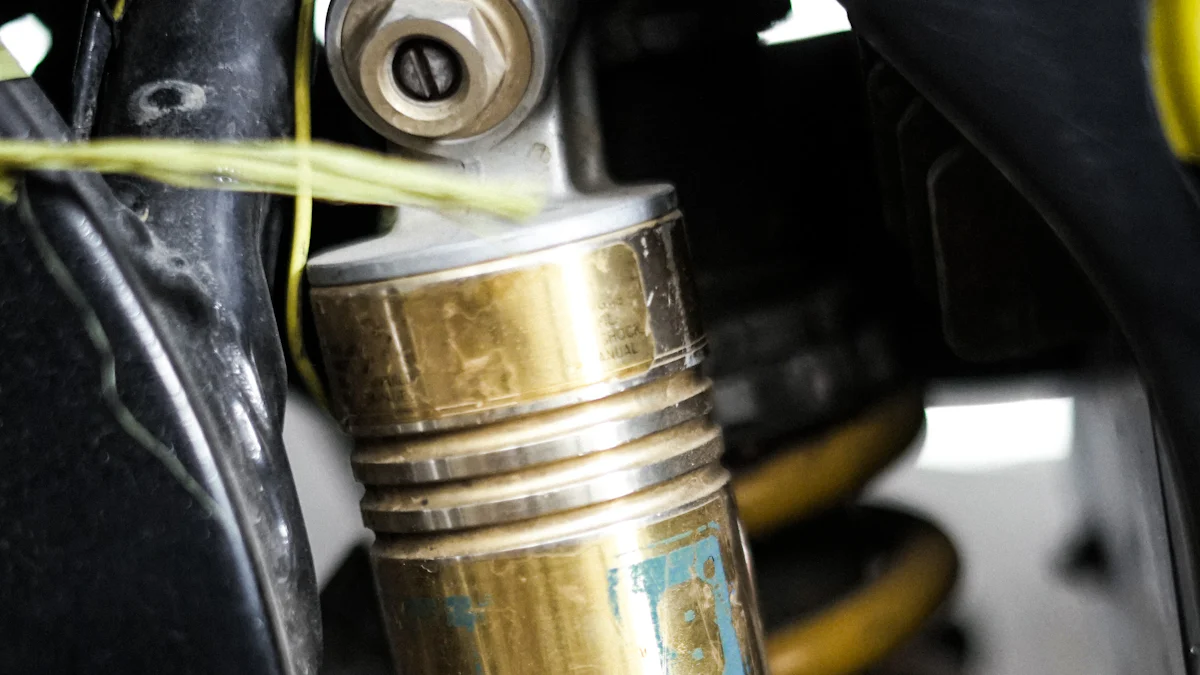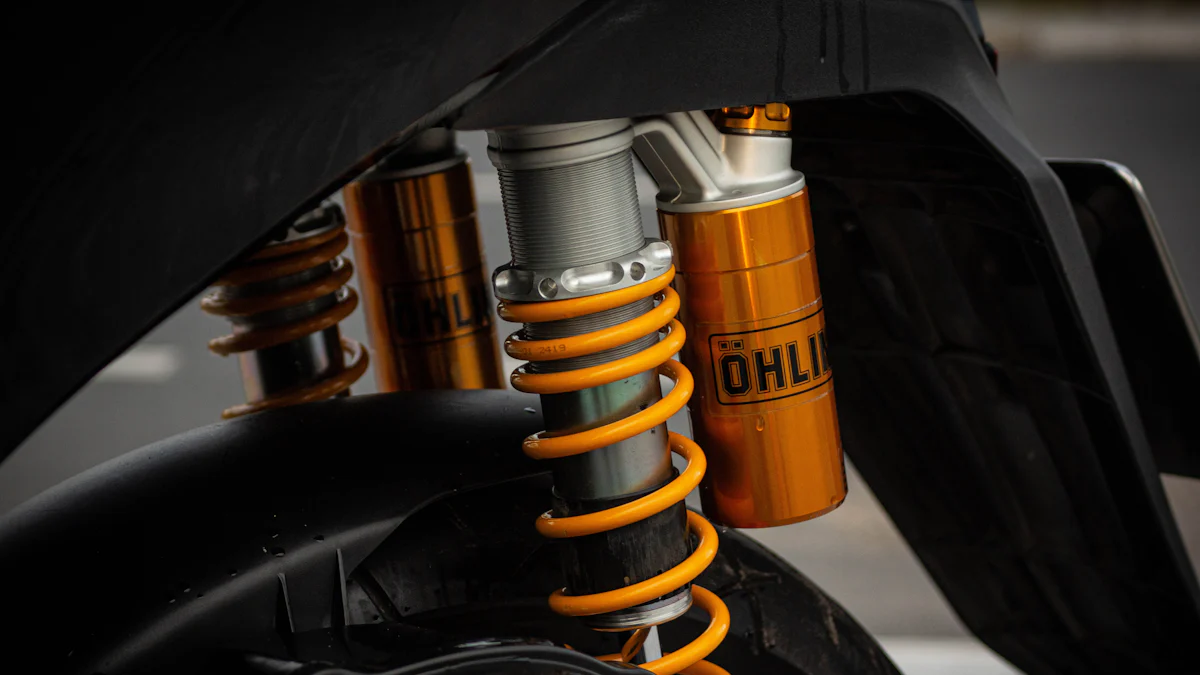
Suspension systems play a crucial role in modern vehicles. These systems ensure a smooth and controlled response to road conditions, enhancing passenger comfort and vehicle handling capabilities. The importance of suspension systems in vehicle dynamics cannot be overstated. Proper alignment of tires and minimized excessive motion contribute to safer driving conditions. High performance dampers, as essential components, absorb and dissipate energy from road bumps, leading to a smoother ride. These advanced dampers also absorb chassis distortion, noise, and vibrations, providing high-quality, comfortable driving experiences.
Understanding Suspension Systems
Basic Components of Suspension Systems
Springs
Springs serve as the backbone of any suspension system. These components absorb and store energy from road impacts. Springs help maintain vehicle height and support the weight of the vehicle. Common types include coil springs, leaf springs, and torsion bars.
Shock Absorbers
Shock absorbers, also known as dampers, control the motion of the springs. These devices convert kinetic energy into heat, dissipating it to reduce oscillations. Effective shock absorbers enhance vehicle stability and ride comfort by minimizing excessive bouncing.
Control Arms
Control arms connect the vehicle’s wheels to the frame. These components allow for controlled movement of the wheels. Control arms play a crucial role in maintaining proper wheel alignment. Different designs include upper and lower control arms, which work together to ensure smooth wheel articulation.
Evolution of Suspension Systems
Early Designs
Early suspension systems relied on simple leaf springs. These designs offered basic shock absorption but lacked sophistication. Early vehicles experienced significant body roll and limited ride comfort. The focus remained on durability rather than performance.
Modern Innovations
Modern suspension systems have evolved significantly. Engineers now integrate advanced materials and technologies. Adaptive damping systems adjust in real-time based on road conditions. These systems use sensors and algorithms to optimize ride quality and handling. Predictive suspension systems anticipate road conditions, further enhancing comfort and stability. The integration of Advanced Driver Assistance Systems (ADAS) has revolutionized vehicle safety and performance. Suspension systems now play a crucial role in real-time adjustments based on ADAS input, ensuring a safer and more comfortable driving experience.
High Performance Dampers: An Overview

What Are High Performance Dampers?
Definition and Function
High performance dampers are specialized components in modern suspension systems. These dampers control the motion of the vehicle’s springs, converting kinetic energy into heat. This process reduces oscillations and enhances vehicle stability. High performance dampers ensure a smooth and controlled response to road conditions. This contributes significantly to passenger comfort and vehicle handling capabilities.
Key Characteristics
High performance dampers possess several key characteristics. These dampers exhibit superior damping effects, even on tiny movements of the vehicle body. Advanced materials and designs enable better heat dissipation. This feature proves crucial in high-performance applications where dampers work harder. High performance dampers also absorb chassis distortion, noise, and vibrations. This results in a quieter and more comfortable driving experience.
Types of High Performance Dampers
Monotube Dampers
Monotube dampers offer distinct advantages in high-performance scenarios. The design allows for better heat dissipation compared to twin-tube dampers. The oil in monotube dampers does not travel through as much material and distance. This efficient heat radiation enhances performance under strenuous conditions. Monotube dampers provide consistent damping, making them ideal for sports cars and other high-performance vehicles.
Twin-tube Dampers
Twin-tube dampers represent another common type of high performance damper. These dampers consist of two nested tubes, with the inner tube housing the piston and the outer tube serving as a reservoir. Twin-tube dampers generally offer a smoother ride quality. These dampers handle a variety of road conditions effectively. Twin-tube dampers often find use in everyday passenger vehicles due to their balance of performance and comfort.
Adjustable Dampers
Adjustable dampers provide flexibility in tuning the suspension system. Drivers can modify the damping characteristics based on driving conditions or personal preferences. Adjustable dampers come in two main types: manually adjustable and electronically adjustable. Manually adjustable dampers require physical adjustment of the settings. Electronically adjustable dampers use sensors and actuators to change settings in real-time. This adaptability makes adjustable dampers suitable for both daily driving and high-performance applications.
Benefits of High Performance Dampers
Enhanced Vehicle Handling
Improved Cornering
High performance dampers significantly enhance cornering capabilities. These dampers reduce body roll by controlling the motion of the vehicle’s springs. This control allows for more precise handling during sharp turns. Vehicles equipped with high performance dampers maintain better tire contact with the road. This results in improved grip and stability. Drivers experience greater confidence when navigating corners at higher speeds.
Stability at High Speeds
Stability at high speeds remains a critical factor for vehicle safety. High performance dampers excel in maintaining vehicle stability under such conditions. These dampers minimize oscillations and vibrations that can destabilize the vehicle. The advanced materials and designs ensure consistent damping performance. This consistency proves essential for high-speed driving, where even minor instabilities can lead to significant issues. High performance dampers provide a smoother and more controlled ride, enhancing overall safety.
Increased Comfort
Smoother Ride Quality
High performance dampers contribute to a smoother ride quality. These dampers effectively absorb and dissipate energy from road bumps. This absorption reduces the impact felt by passengers. The result is a more comfortable driving experience, especially on rough roads. High performance dampers also help maintain consistent ride height. This consistency ensures that the vehicle remains level, further enhancing comfort.
Reduced Vibrations
Vibrations can cause discomfort and fatigue during long drives. High performance dampers play a crucial role in reducing these vibrations. The design of these dampers allows for better dissipation of kinetic energy. This dissipation minimizes the vibrations transmitted to the vehicle’s cabin. Passengers experience less shaking and noise, leading to a quieter and more pleasant journey. The reduction in vibrations also helps protect sensitive vehicle components from wear and tear.
Longevity and Durability
Wear Resistance
High performance dampers offer superior wear resistance compared to standard dampers. The use of advanced materials ensures that these dampers withstand harsh conditions. This durability proves essential for high-performance applications where dampers face greater stress. High performance dampers maintain their effectiveness over a longer period. This longevity translates to fewer replacements and lower maintenance costs.
Maintenance Considerations
Maintenance considerations play a vital role in the overall cost of vehicle ownership. High performance dampers require less frequent maintenance due to their robust construction. The advanced designs and materials used in these dampers reduce the likelihood of failure. Regular inspections and proper care can further extend the lifespan of high performance dampers. Vehicle owners benefit from reduced downtime and lower maintenance expenses.
Case Study: KnitMesh Technologies
A case study by KnitMesh Technologies demonstrated the exceptional performance of knitted mesh vibration dampers in controlling vibrations in harsh industrial environments. The custom-made knitted mesh damper met strict requirements for damping performance and installation space. This real-life scenario illustrates the benefits of high performance dampers in providing enhanced comfort and durability.
Technological Advancements in Dampers
Electronic Dampers
Adaptive Damping Systems
Adaptive damping systems represent a significant leap in suspension technology. These systems use sensors to monitor road conditions and driving behavior in real-time. The vehicle’s computer system processes this data and adjusts the damping characteristics accordingly. This dynamic adjustment optimizes both comfort and handling instantaneously. Smart dampers automatically adapt to various driving scenarios, providing a tailored response for each situation. This level of precision ensures that vehicles equipped with adaptive damping systems offer superior ride quality and stability.
Semi-active and Active Dampers
Semi-active and active dampers further enhance the capabilities of modern suspension systems. Semi-active dampers adjust their damping force based on real-time inputs but do not change their overall structure. Active dampers, on the other hand, can modify both damping force and structural characteristics. These dampers use advanced algorithms to predict and respond to road conditions. This predictive capability allows for immediate adjustments, ensuring optimal performance at all times. The integration of semi-active and active dampers in high performance damper systems provides unparalleled control and comfort.
Materials and Manufacturing Techniques
Lightweight Materials
The use of lightweight materials in high performance dampers has revolutionized suspension design. Engineers now utilize materials such as aluminum and carbon fiber to reduce the overall weight of dampers. This reduction in weight enhances vehicle performance by lowering unsprung mass. Lower unsprung mass improves the responsiveness of the suspension system, leading to better handling and ride quality. Lightweight materials also contribute to improved fuel efficiency, making them an essential component in modern automotive design.
Advanced Manufacturing Processes
Advanced manufacturing processes play a crucial role in the production of high performance dampers. Techniques such as precision machining and additive manufacturing allow for the creation of complex damper components with high accuracy. These processes ensure that each damper meets stringent quality standards and performs reliably under demanding conditions. The use of advanced manufacturing techniques also enables the production of custom dampers tailored to specific vehicle requirements. This customization enhances the overall performance and longevity of high performance dampers.
Impact on Vehicle Performance

Real-world Applications
Sports Cars
High performance dampers play a crucial role in sports cars. These vehicles demand precise handling and stability at high speeds. High performance dampers reduce body roll during sharp turns. This allows for better tire contact with the road, enhancing grip and control. The improved stability ensures safer and more enjoyable driving experiences. Sports car manufacturers often integrate monotube dampers due to their efficient heat dissipation. This feature proves essential during high-speed maneuvers, where consistent damping is critical.
Off-road Vehicles
Off-road vehicles benefit significantly from high performance dampers. These vehicles encounter rough terrains that challenge standard suspension systems. High performance dampers absorb vibrations and impacts from uneven surfaces. This absorption reduces discomfort for passengers and protects vehicle components. Twin-tube dampers are commonly used in off-road applications due to their ability to handle various road conditions. Adjustable dampers offer additional flexibility, allowing drivers to tune the suspension for different terrains. This adaptability enhances both comfort and performance during off-road adventures.
Case Studies
Performance Metrics
Several case studies highlight the effectiveness of high performance dampers. One notable example involves a comparison between vehicles equipped with standard dampers and those with high performance dampers. The study measured various performance metrics, including handling, stability, and ride comfort. Vehicles with high performance dampers showed significant improvements in all areas. Enhanced damping reduced chassis distortion and vibrations, leading to a smoother ride. The advanced materials used in these dampers also contributed to better heat dissipation and wear resistance.
User Feedback
User feedback provides valuable insights into the real-world benefits of high performance dampers. Drivers consistently report improved handling and stability, especially during high-speed driving. Many users note a noticeable reduction in vibrations and noise within the cabin. This improvement enhances overall ride comfort, making long-distance drives more enjoyable. Off-road enthusiasts appreciate the ability to adjust damping characteristics based on terrain. This flexibility allows for a tailored driving experience, whether navigating rocky trails or smooth highways. The positive feedback underscores the importance of high performance dampers in modern suspension systems.
Future Perspectives
Emerging Trends
Integration with Autonomous Vehicles
Autonomous vehicles represent the future of transportation. High performance dampers will play a critical role in this evolution. These dampers will ensure smooth and stable rides for autonomous vehicles. Advanced sensors will monitor road conditions in real-time. The system will adjust damping characteristics to optimize comfort and safety. This integration will enhance passenger experiences in self-driving cars.
Smart Suspension Systems
Smart suspension systems are another emerging trend. These systems use advanced algorithms to predict and respond to road conditions. Sensors collect data on vehicle dynamics and road surfaces. The system processes this data to adjust damping in real-time. This technology will improve ride quality and handling. Smart suspension systems will also contribute to fuel efficiency. Reduced vibrations and optimized damping will lower energy consumption.
Research and Development
Ongoing Innovations
The automotive industry continues to innovate in suspension technology. Engineers are developing new materials for high performance dampers. Lightweight materials like carbon fiber reduce unsprung mass. This reduction improves vehicle responsiveness and handling. Advanced manufacturing techniques allow for precise damper components. Customization of dampers to specific vehicle needs enhances performance.
Potential Breakthroughs
Future breakthroughs in damper technology hold great promise. Researchers are exploring adaptive damping systems. These systems will use machine learning to predict road conditions. Real-time adjustments will provide unparalleled ride comfort and stability. Another potential breakthrough involves active dampers. These dampers will modify both damping force and structural characteristics. This capability will offer superior control and adaptability. The relentless pursuit of innovation will continue to drive advancements in high performance dampers.
High performance dampers play a pivotal role in modern suspension systems. These components enhance vehicle handling, stability, and comfort. Advanced materials and designs ensure superior damping effects and heat dissipation. Technological advancements like adaptive damping systems and electronically adjustable dampers provide real-time adjustments for optimal performance. The future of suspension systems looks promising with ongoing innovations and potential breakthroughs. High performance dampers will continue to be essential in improving driving experiences and vehicle safety.
Post time: Jul-31-2024



